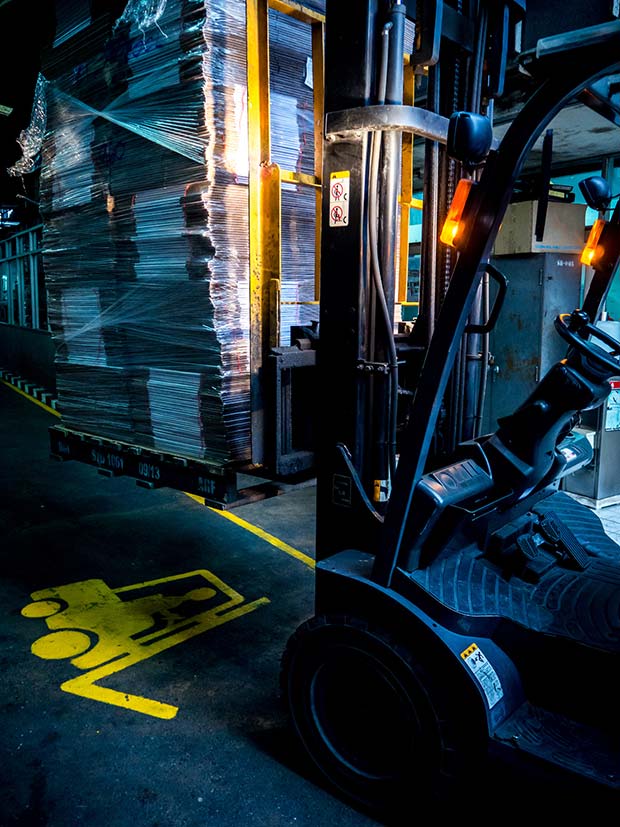As electric motors increasingly replace internal combustion engines in warehouse and production area vehicles, the quality and performance of their motive power batteries is coming under increasing scrutiny. While traditional lead-acid types remain popular and reliable, newer and more innovative lead-acid technologies, as well as alternatives such as lithium-ion (Li-ion) are giving operators many opportunities to significantly improve their daily operations strategy and reduce total cost of ownership (TCO).
 Below are ten key points for users to consider while seeking to benefit from these new technologies:
Below are ten key points for users to consider while seeking to benefit from these new technologies:
#1 Maximising the vehicles’ time in productive use
Challenge: When using vehicles with traditional batteries in multishift operations, production time is lost as discharged batteries must be exchanged. Spare batteries also incur extra cost and space.
Solution: Thin Plate Pure Lead (TPPL) VRLA batteries allow vehicles to be used continuously, even in a multi-shift. TPPL batteries accept high charge rates, and allow charging during natural breaks within a shift; the batteries stay within the truck, swap out time is eliminated.
# 2 Charging in situ without health risk or product contamination
Challenge:Flooded cell batteries release oxy-hydrogen gas and acid vapours during charging. They must be charged within a dedicated room with extraction capability to avoid health risks and contamination.
Solution: Choose batteries that do not gas during charging to eliminate risks. The cost and space of supplying an equipped charging room is avoided, as is disruption of vehicles traversing between areas.
#3 Keeping control of maintenance costs
Challenge: Flooded cell batteries have a significant maintenance requirement, with a need for regular water top-ups. These are timeconsuming, pose risks for operators and to the factory floor and, in larger facilities, incur substantial water bills.
Solution: More recent VRLA leadacid types save maintenance time, risk and costs as their internal recombination processes mean that they do not require top-ups.
#4 Minimising energy costs
Challenge:Flooded lead-acid batteries require overcharging levels of 10 – 20% to generate acid mixing and minimise stratification. This adds to the facility’s energy costs and impacts its green footprint.
Solution:Battery technologies available today require lower overcharging, at typically 8 – 10%. Up to 30% energy savings can be achieved.
#5 Reducing replacement rates for batteries
Challenge: Ongoing capital costs for traditional batteries are higher than necessary because of their operational life cycle limits.
Solution: Lead-acid batteries offer savings through improved operating life, with expectation of 1500 – 1600 cycles at 60% Depth of Discharge (DoD) for current designs. They are ideal to be used in Partial State of Charge (PSoC) applications.
#6 Reducing space requirements in electric vehicles
Challenge: Compact trucks are required for confined areas.
Solution: Plate sizes have reduced from 9 to 1mm thickness in some products; this allows 30% space savings compared with equivalent AGM types.
#7 The cost and organisation required for spare battery storage
Challenge: Conventional batteries must be recharged every six to twelve weeks during storage. Resources are required for monitoring the open circuit voltage of batteries in inventory, and boost charging when necessary.
Solution: Latest-technology leadacid AGM batteries can be stored for up to two years at 68°F when starting from a fully-charged condition; this reduces monitoring and boost charging requirement and cost.
#8 Minimising battery capital costs
Challenge: There is widespread industry interest in Li-ion batteries as a replacement for lead-acid, but one drawback of Li-ion technology is cost.
Solution: The latest lead-acid battery technologies, while offering many technical advantages, have a cost factor of 1.4 to 1.6 compared with standard lead-acid types. By contrast, many Li-ion batteries carry a historical cost factor of 4 to 6 over lead-acid.
#9 Recycling to reduce costs and environmental damage
Challenge: All batteries have finite operating lifetimes, disposing of them with minimal environmental impact and cost is a concern.
Solution: Li-ion batteries present difficulties. All Li-ion types must be analysed to determine whether they contain valuable materials. Lithium iron phosphate recycling is currently hardly worthwhile, while with lithium cobalt oxide batteries the cobalt can be recovered and corresponds to about 10% of the new cell value. However, Li-ion recyclability is anticipated to improve. Lead-acid batteries, are easily and virtually completely recyclable.
#10 Robust batteries for challenging conditions
Challenge: Batteries can be subject to harsh environments, with shock and vibration, wide temperature ranges and heavy-handed treatment from inexperienced personnel.
Solution: The grain structure of the pure lead used in TPPL batteries makes the plates less susceptible to corrosion. They are also resistant to harsh shock and vibration, due to rugged construction and vibrationresistant compound. They have a much wider operating temperature range than other lead-acid batteries.
TPPL TECHNOLOGY




Comments are closed.